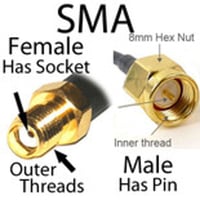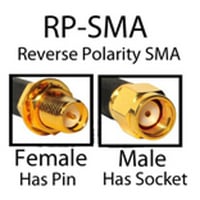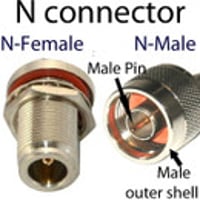Antennas with FME Connector
FME Antennas: Antennas with FME Connectors
FME antennas are radio antennas that are terminated with an FME connector for connection to antenna cables and other radio frequency equipment. FME stands for “For Mobile Equipment”and denotes this radio frequency connector type as being primarily for vehicles and other mobile applications. Antennas are usually terminated with an FME jack (FME female).
What is an FME connector?
The FME connector (also known as the nipple connector or SAP connector ) is a miniature connector that has been developed specifically for mobile applications where antennas and cable assemblies may be subject to vibrations and mechanical forces. Its small and compact design also allows cables with this connector to be snaked through small spaces in vehicles, mobile phones, and other portable devices.
FME connector specifications
- Physical features
FME antenna connectors are threaded barrel-shaped connectors that mate by screw-coupling. As with most threaded connectors, the male threads are internalized and the female threads are externalized. There carry a hex nut and flats that allow tightening with a wrench. Most FME connectors are rated for at least 500 mating cycles. The diameter of the female connector is 0.276 inches (7 millimeters) and the threading has an 8mm (M8) by 0.75 mm pitch. The body of FME connectors is brass and typically nickel-plated, with a gold plated center pin on the male and a phosphor bronze receptacle on the female. The insulator material is made either from PTFE (Teflon) or Delrin plastic. In the female connector, the insulating material forms a white plastic tip with the receptacle housed within. It is this protrusion that gives rise to the nipple connector name. FME connectors are available in bulkhead and panel mounted versions and can be obtained with a right-angle orientation.
- Electrical specs
The FME connector has an impedance of 50 Ohms. Its frequency range is DC to 2000 MHz (2 GHz), and sometimes higher depending on the manufacturer. Its VSWR is 1.3 and the electrical working voltage is 500 V.
- FME antenna frequencies
The frequency range of the FME connector means it performs best at frequencies below 2 GHz. Typical frequency bands of FME antennas include:
- 824-960 MHz
- 1710-1990 MHz
These frequencies support cellular and amateur radio connectivity as explored below.
Why is an FME antenna important?
This slim and compact connector lends itself to several applications as outlined below. FME connectors are designed to be fitted to low loss coaxial cable like RG-58, RG-8X RG-174, Belden 7806A, or LMR 195 and the straight connector will provide easier assembly in tight spaces. It is of a similar caliber to the mini-UHF connector and is used as a more modern alternative in similar applications.
Advantages of a threaded connection
FME connector antennas deliver reliable performance for both static and mobile applications as its threaded connection is secure, stable, and provides high mechanical strength. Threaded connections assist in maintaining the electrical performance necessary for microwave frequencies in environments where there may be severe vibration. Forces acting on the cable the antenna is connected to will affect the coupling mechanism but the additional PTFE insulation in the female FME dielectric interface will shield the inner connection between the pin and the receptacle. For optimal performance, the FME connector must be correctly tightened.
[A] FME whip antenna
Whip antennas are made from a flexible wire or road that serves as the antennas element. They are monopole antennas. The length of the antenna is usually proportional to the wavelength of its frequency, with many being half or quarter-wave antennas. They are mounted with or without a ground plane, with the FME connector at their termination. They are flexible and unlikely to break if impacted or bent.
[B] FME dipole antenna
Dipole antennas are composed of paired antenna elements with a feedline between them. They are simple but provide reliable performance. Dipole antennas also have a length that is usually in proportion to the wavelength of their respective frequencies.
[C] FME helix antenna
Helix antennas are made from a half or quarter-wave element that is coiled into a helix. The rubber ducky antennas found on some Ham radio transceivers are a type of helix antenna.
Key applications of FME antennas
Portable Transceivers Ham radio
The FME connector is not commonly used in Ham radio, but it may be present in transceivers and antennas that operate in frequencies close to the cellular bands. An example is the 33-centimeter band. The FME connector antenna can be readily adapted for use with equipment that carries a UHF, TNC, BNC, or connector.
FME cellular antennas
FME connectors are commonly used in mobile applications and FME antennas can support the frequencies commonly used by the major cellular 2G, 3G, and 4G technologies including:
- GSM (850 MHz and 1900 MHz). Global System for Mobile Communications is a second-generation (2G) cellular networking technology that provides voice telephony and the transfer of data by using GPRS or EDGE extension technology.
- CDMA (800 MHz and 1900 MHz) is a mobile standard that uses Code-division multiple access (CDMA) to enable several transmitters to exchange data simultaneously on a single communications channel. It is a third-generation (3G) cellular technology.
- LTE (850 MHz and 1900 MHz). Long Term Evolution is a third and fourth generation cellular technology that builds existing second and third-generation infrastructure and technology to improve speeds and network capacity.
FME cellular antennas can be used to improve cellular coverage and the quality of connectivity in a range of settings. Often the use of cellular antennas with a cellular booster will improve data transfer rates or mean that additional services like video calling can be accessed from the network operator.
FME antennas for marine
FME antennas are increasingly used in antennas for marine use. The threaded and plastic sealed connection holds up well in marine conditions. Both amateur and professional boaters find that the small diameter of the connector makes routing cable through the decking and conduits of a boat far simpler. Antenna cables are often one of the last types of cable to be fitted in a yacht, so FME connectors make the job easy. Also, FME connectors have a wide range of adapters meaning that cable assemblies with common radio frequency connectors like BNC can be connected if a VHF antenna needs to be swapped in.
Frequently asked questions
How do connect a male FME connector to coax?
Most cables will need to be terminated with a male connector (plug), as the antennas usually carry a jack.
Most FME connectors can be attached to cable via a crimp connection. The conducting pin may need to be soldered. The RG-58 coaxial cable can be stripped down with a cable stripper and the Teflon dielectric cut back carefully to expose the necessary length of the inner conducting wire. The connector's pin is either crimped or soldered onto the inner conducting wire. The connector body can then be threaded on and crimped into place.
Assembling FME antenna cables may be difficult if you are new to the task. Purchasing a quality pre-assembled FME cable may deliver better performance.
How do you tighten an FME connector?
As the FME connector is almost the same diameter as the cable, it can be difficult to hand tighten the connector adequately. A loose connection will mean that the FME antenna performs poorly or not at all.
The FME connector carries an 8-millimeter nut which can be tightened to the appropriate torque with a wrench. Tighten at the nut only, not the connector body, or by rotating the antenna. Do not tighten beyond the initial break-point.
In conclusion
FME antennas are equipped with a versatile and easily adapted connector that can withstand the challenges of environments and applications where sound performance while mobile is critical. These antennas complement cable installations that have used the FME connector because of the ease of routing it delivers.
LEARN MORE:







